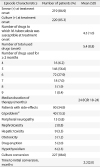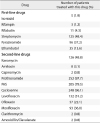1. World Health Organization. Global tuberculosis report 2015. WHO/HTM/TB 2015.10. Geneva: World Health Organization;2015.
2. Jeon CY, Hwang SH, Min JH, Prevots DR, Goldfeder LC, Lee HY, et al. Extensively Drugs-Resistant Tuberculosis in South Korea: Risk Factors and Treatment Outcomes among Patients at a Tertiary Referral Hospital. Clin Infect Dis. 2008; 46:42–49.

3. Annual report on the notified tuberculosis patients in Korea. Seoul, South Korea: Korean Center for Disease control and Prevention Korean institute for Tuberculosis;2005.
4. Hong YP, Kim SJ, Lew WJ, Lee SH, Lee EK. Cohort analyses of the treatment of smear-positive pulmonary tuberculosis patients under programme conditions in Korea, 1983-1994. Int J Tuberc Lung Dis. 1998; 2:365–371.
5. Seung KJ, Bai GH, Kim SJ, Lew WJ, Park SK, Kim JY. The treatment of tuberculosis in South Korea. Int J Tuberc Lung Dis. 2003; 7:912–919.
6. Park WS, Kang HY, Kim SJ, Cha JO, Son HJ, Park O. Notified tuberculosis status in Korea, 2015. Public Health Weekly Report, KCD. 2015; 9(19):342–345.
7. World Health Organization. Definitions and reporting framework for tuberculosis – 2013 revision. WHO/HTM/TB/2013.2. Geneva: World Health Organization;2013.
8. Leimane V, Riekstina V, Holtz TH, Skripconoka V, Thorpe LE, Laserson KF. Clinical outcome of individualized treatment of multidrug-resistant tuberculosis in Latvia: a retrospective cohort study. Lancet. 2005; 365:318–326.

9. Kwon YS, Kim YH, Suh GY, Chung MP, Kim H, Kwon OJ. Treatment outcomes for HIV-Unifected Patients with Multidurg-Resistant and Extensively Drug-Resistant. Tuberculosis – Clin Infect Dis. 2008; 47:496–502.

10. Putri FA, Burhan E, Nawas A, Soepandi PZ, Sutoyo DK, Agustin H. Body mass index predictive of sputum culture conversion among MDR-TB patients in Indonesia. Int J Tuberc Lung Dis. 2014; 18(5):564–570.

11. Bastos ML, Hussain H, Weyer K, Garcia-Garcia L, Leimane V, Leung CC, et al. Treatment outcomes of patients with multidrug-resistant and extensively drug-resistant tuberculosis according to drug susceptibility testing to firs- and second-line drugs: An individual patient data Meta-analysis. Clin Infect Dis. 2014; 59(10):1364–1374.
12. Ahuja SD, Ashkin D, Avendano M, Banerjee R, Bauer M, Bayona JN. Multidurg resistant pulmonary tucerculosis treatment regimens and patient outcomes: An individual patient data Meta-analysis of 9,153 patients. PLoS Med. 2012; 9(8):e1001300. DOI:
10.1371/journal.pmed.1001300.
13. Tsukamura M. In vitro antituberculosis activity of a new antibacterial substance ofloxacin (DL8280). Am Rev Respir Dis. 1985; 131:348–351.
14. Willcox PA, Groenewald PJ, Mackenizie CR. Ofloxacin-based chemotherapy in multiply durg-resistant pulmonary tuberculosis. Drugs. 1993; 45:suppl 3. S223–S224.
15. Yew WW, Chan CK, Chau CH, Tam CM, Leung CC, Wong PC. Outcomes of patients with multidrug-resistant pulmonary tuberculosis treated with ofloxacin/levofloxacin-containing regimens. Chest. 2000; 117:744–751.

16. Leimane V, Dracniece G, Riekstina V, Sture I, Kammerer S, Chen MP. Treatment oucome of multidrug/extensicely drug-resistant tuberculosis in Latvia, 2000-2004. Eur Respir J. 2010; 36(3):584–593.

17. Schwenk A, Hodson L, Wright A, Ward LC, Rayner CF, Grubnic S. Nutrient partitioning during treatment of tuberculosis: gain in body fat mass but not in protein mass. Am J Clin Nutr. 2004; 79:1006–1012.

18. Jo KW, Lee SD, Kim WS, Kim DS, Shim TS. Treatment outcomes and moxifloxacin susceptibility in ofloxacin-resistant multidrug-resistant tuberculosis. Int J Tuberc Lung Dis. 2014; 18(1):39–43.

19. Faustini A, Hall AJ, Perucci CA. Risk factors for multidrug resistant tuberculosis in Europe: a systematic review. Thorax. 2006; 61:158–163.

20. Pablos-Mendez A, Rabiglione MC, Laszlo A, Binkin N, Rieder HL, Bustreo F. Global surveillance for antituberculosis-drug resistance, 1994-1997. World Health Organization-International Union against Tuberculosis and Lung Disease Working Group on Anti-Tuberculosis Drug Resistance. N Engl J Med. 1998; 338(23):1641–1649.






 PDF
PDF ePub
ePub Citation
Citation Print
Print






 XML Download
XML Download